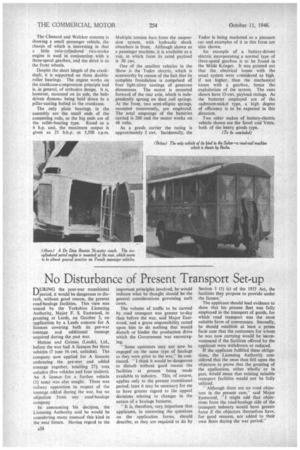No Disturbance of Present Transport Set-up
Page 36

If you've noticed an error in this article please click here to report it so we can fix it.
DURING the post-war transitional period, it would be dangerous to disturb, without good reason, the present road-haulage facilities. This view was voiced by the Yorkshire Licensing Authority, Major F. S. Eastwood, in granting at Leeds, on October 3, an application by a Leeds concern for A licences covering both its pre-war 1onnage and additional tonnage acquired during the past war.
Hutton and Grimes (Leeds), Ltd., before the war had A licences for three vehicles (7 tons 16 cwt. unladen). The company now applied for A licences embracing the pre-war and added tonnage together, totalling 27i tons unladen (five vehicles and four trailers). An A licence for a further vehicle (2i tons) was also sought. There was railway opposition in respect of the tonnage added during the war, but no objection from any road-haulage company In announcing his decision, the Licensing Authority said he would be considering many casessof this kind in the near future. Having regard to the important principles involved, he would indicate what he thought should be the general considerations governing such cases.
The volume of traffic to be carried by road transport was greater to-day than before the war, said Major Eastwood, and a grave responsibility rested upon him to do nothing that 'would disturb or hinder the production drive which the Government was encouraging.
" Some operators may not now be engaged on the same type of haulage as they were prior to the war," he continued. "I think it would be dangerous to disturb without good reason the facilities at present being made available to industry. This, of course, applies only to the present transitional period; later it may be necessary for me to have greater regard to the appeal decisions relating to changes in the nature of a haulage business.
" It is, therefore, very important that applicants, in answering the questions On the application forms, should describe, as they are required to do by Section 5 (1) (c) of the 1933 Act, the facilities they propose to provide under the licence."
The applicant should lead evidence to show that his present fleet was fully employed in the transport of goods, for which road transport was the most suitable form of conveyance. Secondly, he should establish at least a prima facie case that the customers for whom he was now carrying would be inconvenienced if the facilities offered by the applicant were withdrawn or reduced.
If the applicant fulfilled these obligations, the Licensing Authority considered that the onus then fell upon the objectors to prove that the granting of the application, either wholly or in part, would mean that existing suitable transport facilities would not be fully utilized.
" Although there are no road objectors in the present case," said Major Eastwood, "1 might add that objections from the road-haulage side of the transport industry would have greater force if the objectors themselves have, for good reasons, not added to their own fleets during the war period."




































































